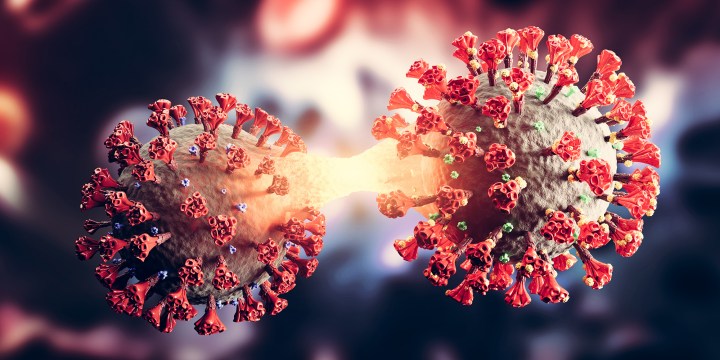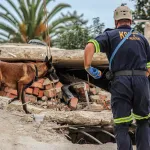PANDEMIC UPDATE
‘Kraken’ Covid-19 subvariant detected in SA — but is unlikely to cause rise in severe infections

South African scientists have found the ‘Kraken’ subvariant of the Omicron variant of the SARS-CoV-2 virus in local samples. But there is no need to panic, vaccinology professor Shabir Madhi said on Sunday. He stressed that it was unlikely the subvariant would cause an increase in severe Covid-19 cases.
A subvariant of Omicron, XBB.1.5 — dubbed “Kraken” by international media — is the driving force behind vast waves of Covid-19 infections worldwide and has been found in a South African sample.
This was confirmed on Friday in a tweet by Professor Tulio de Oliveira, the director of the Centre for Epidemic Response and Innovation at Stellenbosch University and the KZN Research Innovation and Sequencing Platform at the University of KwaZulu-Natal.
He said teams looking for new variants and subvariants of the SARS-CoV-2 virus had found XBB.1.5 in South Africa. Scientists found the subvariant in one of 97 samples tested. The sample was taken on 27 December 2022.
Dean of Wits University’s Faculty of Health Sciences Professor Shabir Madhi questioned the value of publicising this on social media.
“It is unclear what value exists in publicising something on social media which is not clinically relevant. We need to become more circumspect about sharing on Twitter what remains an ever-evolving variant for the past year with repeated claims of greater transmissibility which generally has remained clinically irrelevant in settings with high levels of immunity against severe disease.
“The data from the United States, where XBB.1.5 dominates, does not show any significant upswing in hospitalisation. In South Africa, hospitalisation for Covid-19 still occurs, although at low rates, which is to be expected.
“Even if XBB.1.5 is more transmissible and more able to evade antibody neutralising activity, there is no indication that it is assailing T-cell immunity, mediating protection against severe disease.
“In South Africa, where almost two-thirds of the population was infected with BA.1 [Omicron], such infection confers protection against XBB.1.5 and even more so in people who have also been vaccinated.”
China situation
In its latest statement on the outbreak in China, issued on 3 January, the World Health Organization’s Technical Advisory Group on Virus Evolution (TAG-VE) noted the rapidly increasing proportion of XBB.1.5 cases and said an updated risk assessment of XBB.1.5 was in progress.
TAG-VE, which is monitoring more than 500 subvariants of Omicron, meets regularly to review the latest scientific evidence on circulating SARS-CoV-2 variants and advises the WHO on whether a change in public health strategies is warranted.
According to the statement, scientists from the Chinese Centre for Disease Control and Prevention analysed more than 2,000 samples for locally acquired infections from 1 December 2022 and found that 97% of cases were caused by two subvariants — Omicron BA.5.2 and BF.7.
“At present, no new variant has been reported by the China CDC,” the statement continued, and urged countries to continue viral sequencing, which can assist in a timely global risk assessment.
Where did XBB come from?
The XBB subvariant was formed when two other sublineages, BA.2.10.1 and BA.2.75, combined. In October, the global prevalence of XBB was 1.3%, and it had been detected in 35 countries. Early evidence on clinical severity and reinfection risk presented to TAG-VE did not suggest a significant change in severity from the original Omicron variant. However, the evidence presented in October indicated that it was more contagious, especially among patients who did not have a previous Omicron infection, even if they had one of the other variants.
WHO emergency committee sitting
During a press conference in December, Dr Maria van Kerkhove from the World Health Organization said the organisation would decide in January to decide whether to lift its declaration of the Covid-19 outbreak as a public health emergency of international concern.
“The impact is not what it was in the beginning,” she said, adding that since Omicron became the dominant variant, there had been a decoupling between the number of infections, hospitalisations and deaths.
In a separate video statement, she said the strategy to cope with recent increases in infections remained the same: vaccinations, boosters and wearing masks. Globally, 8,000 to 10,000 deaths caused by Covid-19 are recorded every week, but this is much lower than it has been.
The WHO’s director-general, Tedros Ghebreyesus, said that globally the situation was significantly better than earlier in the pandemic. He said the SARS-COV-2 virus was now “almost part of the family,” and there were better tools and knowledge to deal with any outbreak, as well as significant population immunity.
Flight bans
In response to the current outbreak in China, the US Centers for Disease Control and Prevention instituted a requirement of a negative Covid-19 test or documentation of recovery for air passengers boarding flights to the US originating from the People’s Republic of China, Hong Kong and Macau.
The reason was the “lack of adequate and transparent epidemiological and viral genomic sequence data being reported” from China. Several other countries followed suit, while South Africa’s Department of Health said it would monitor the situation.
South African situation
According to the National Institute for Communicable Diseases’ daily report, South Africa has a low incidence rate of 6.79 cases per 100,000 of the population.
There has been a significant increase from 17 December 2022, when the last weekly epidemiological report was published. According to this report, the highest incidence rate was in KwaZulu-Natal (3.1 cases per 100,000 persons), followed by Western Cape (2.9 cases per 100,000 persons) and Gauteng (2.4 cases per 100 000 persons). The other provinces reported weekly incidence rates below 2.0 cases per 100,000 persons.
According to the latest wastewater surveillance results for South Africa, the levels of viral particles detected remain low. The latest report from teams tracking variants in South Africa, published on 23 December, shows that Omicron BA.5 and its sublineages are still dominant in South Africa. DM/MC


















 Become an Insider
Become an Insider
Comments - Please login in order to comment.